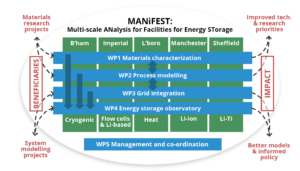Work Packages

WP1 – Characterisation and processing of electrochemical and thermal materials for grid scale storage applications (Lead: Professor Nigel Brandon, Imperial College London)
Summary: This WP is focussed on bringing together the broad suite of new materials processing and characterisation facilities established across the consortia, and applying them to address two challenging questions. Firstly, how can material structures be designed across the nano, micro and meso-scales to deliver performance and lifetime in grid scale applications, and secondly how do these structure change during the long term operation needed in many such applications?
Task 1.1 Development and processing of structured materials for grid scale energy storage
Task 1.2 Understanding chemical, morphological and structural degradation for long term operation
WP2 – Multiscale modelling of energy storage systems and experimental validation (Lead: Professor Yulong Ding, University of Birmingham)
Summary: The modelling of energy storage systems is an extremely challenging task due to the very large temporal and spatial scales, and the complexities in bridging these time and/or length scales. Considerable effort has been made in recent years on energy storage related modelling; see for example Wu et al (2013)9, Lee et al (2013)10, Li et al (2013)11, Islam and Fisher (2014)12, Wang et al (2015)13 and Li et al (2015)14. However, these modelling studies have been mostly at a single unit scale and little effort has been made so far to address the full range of length scales involved in energy storage systems. This WP will bridge between the materials research under WP1 and the system integration under WP3. The research will bring together different modelling capabilities across the consortium and use the capabilities to address the following challenging questions:
- How to relate system level performance to the fundamental properties of the energy storage materials (from WP1)?
- What levels of fundamental properties have to be represented at system level (into WP3)?
- How changes of the materials structure and properties (from WP1) during applications affect the system level performance (into WP3)?
- How do the transport phenomena at different length scales and the manufacturing processes involved affect the performance at the system level (into WP3)?
- How to validate models of different length scales through experimental tools that may not be able to deal with the corresponding length scales?
Task 2.1 Bridging gaps in the modelling of energy storage systems
Task 2.2 Experimental validation of multiscale modelling of electrochemical energy storage systems using Li-ion batteries
Task 2.3 Experimental validation of multiscale modelling of cryogenic and thermal energy storage
WP3 – Grid Integration (Lead: Professor Andrew Forsyth, University of Manchester)
Summary: This Work Package will examine the control and performance of storage assets at the equipment level and also on the wider grid scale, blending the use of physical pilot plants with high performance simulation using the WP2 models, realtime data links and hardware-in-the-loop techniques. The increasing use of renewable and distributed energy resources coupled with the emergence of new forms of electrical load such as vehicle charging is creating a range of evolving challenges for the operation and management of electricity networks. Energy storage offers a potential solution to reconcile supply and demand in future generation-limited low carbon grids, but many questions remain with regard to the type of storage, its size and location, the control and coordination between storage systems and generators, the through-life costs and the business models that will incentivise / reward storage providers. The diverse grid requirements range from high-energy, bulk buffering for renewables, or heavy industry, to rapid response ancillary services for grid reinforcement, such as frequency regulation and stability management. The research addresses the overarching question: how can we meet current and future system needs through control and integration of technologies with different characteristics (response times, power/energy ratios, lifetime, cycling), operating as single entities or as virtual power plants (VPPs). There are three work areas which draw specifically on the large-scale facilities that have been established through the capital grant and wherever possible build collaborative links between the complementary strands of research in the consortium
Task 3.1 Electrochemical storage system design, operation and optimisation
Task 3.2 Thermal storage system design / operation and optimisation
Task 3.3 Grid-wide control and coordination
WP4 – National Energy Storage Observatory (Lead: Dr Jonathan Radcliffe, University of Birmingham)
Summary: The primary aim of this WP is to assess data and disseminate information from the energy storage capital grant facilities, maximising the value of those investments. Dissemination will be through a national ‘observatory’ for energy storage: this web-based portal will hold information on the facilities, research outputs from WPs 1 – 3, and provide access to data from operational runs of the pilot plants. We will also assess the performance of the pilot plants, over time, against performance metrics, using the captured data. Whilst there is a growing number of energy storage demonstrator sites in the UK and globally, there is little data available on their operation. As well as experimental research equipment, the capital grants funded the building of energy storage pilot plants on university campuses at Birmingham, Manchester, Newcastle and Nottingham, together with the Sheffield facility at Willenhall on a public distribution network. These test-beds will allow systematic and comparative studies of energy storage technologies to an extent that is not possible with industrial demonstrators. It will allow sharing of data between centres and with others, with the technology options assessed side-by-side, to identify gaps and inform future policy and innovation decisions. By creating a network of such national facilities, and providing access to their output through a national energy storage observatory, the UK can be established as an innovation hub. We will make use of existing RCUK facilities through UKERC’s Energy Data Centre, which is run by STFC’s Energy Research Unit and stores data in the Centre for Environmental Data Analysis (CEDA) – a well-established national data repository. We will also engage with the wider energy programme where projects need to parametrise energy storage into systems models. Although outside the scope of this project we will explore how data from other demonstration activities in the UK (for example, those publically funded by Ofgem and DECC) and Europe can be incorporated into the observatory, and grow it as a resource. We have support from Government and industry to pursue this activity – described in the Pathways to Impact statement.
Task 4.1 Design
Task 4.2 Operate and collect pilot plant operational data
Task 4.3 Analyse and engage
